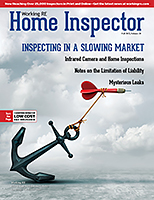 | > E&O/GL Insurance for Home Inspectors Competitive Rates, Broad Coverage, Free Risk Management, online inspection support for tough questions, discounts on education and more… Professional Coverage, Competitive Pricing Shop OREP today! |
Notes on the Limitation of Liability
By Kendra Budd, Associate Editor
Odds are, if a limitation of liability clause is allowed in your state, you’ve already included it in your pre-inspection agreement. However, the legality of the clause can be confusing and difficult for your clients to understand, making it easier for them to sue you if something goes wrong in their new home. It can be hard to know how to properly outline this clause both legally and for your client to have a full understanding of it.
In December 2021, Isaac Peck, President of OREP Insurance gave a presentation on Pre-Inspection Agreements. In it, he highlighted the importance of the limitation of liability clause, and how to sharpen it.
Here’s what we learned.
Limitation of Liability in Detail
As a home inspector, your limitation of liability can simply restrict the price of liability to an amount equal to your inspection fee. This means when a client signs your pre-inspection agreement, they are agreeing that the maximum amount that you, the inspector, is responsible for is the total cost of the inspection. A vast majority of home inspectors choose this approach however; there are other ways to write this clause—especially depending on your state laws.
In his presentation titled “Sharpening Your Pre-Inspection Agreement,” Peck, points out that another way to approach the limitation of liability is to set a higher base amount for the limitation of liability. For example, instead of limiting the maximum liability to the inspection fee, you could set your maximum liability between $1,000 to $2,000, or even two or three times the cost of the inspection fee.
One reason you might do this is, it could be more defensible in court depending on the state law and precedent in your state. Peck points out that some states have completely banned the limitation of liability, or some have strict constraints around it. He uses California as an example. Their law states, “contractual provisions that purport to waive the duty owed pursuant to Section 7196, or limit the liability of the home inspector to the cost of the home inspection report are contrary to public policy and invalid.”
In other words, in California, it is against public policy to limit your liability to the cost of the inspection. However, you might have a more defensible argument if you limit your liability to $2,000, $3,000, or even $5,000. This is definitely a case of something being better than nothing—and is precisely why some inspectors may choose to set a higher price of limitation—some don’t even include a maximum at all.
Choosing how you outline a limitation of liability clause all depends on you, your business and your state laws. All of these are great options so be sure to consider all of your choices before writing your pre-inspection agreement. The next step is how to format the clause.
Unconscionability
Unconscionability is an important concept for you to understand when it comes to the limitation of liability clause. Peck outlines that unconscionability refers to a doctrine in contract law where the terms are unjust, unclear or unreasonable. “Generally speaking, it will involve exploitation of a stronger party by a weaker party,” says Peck.
Several states have made laws against unconscionability and many courts will not uphold a contract if they feel it was unconscionable in nature. State courts have different interpretations of what makes a contract “unconscionable,” but it’s widely understood in the legal community to refer to terms that are substantially unfair and one-sided. For example, South Carolina defines unconscionability as the “absence of meaningful choice on the part of one party due to one-sided contract provisions, together with terms that are so oppressive that no reasonable person would make them and no fair and honest person would accept them.”
The prospects that your limitation of liability will be held up as unconscionable might be a good reason to (A) set a slightly higher limitation of liability price, such as $2,000, and (B) make the clause conspicuous.
(story continues below)
(story continues)
Make it Conspicuous
As well as making your limitation of liability conscionable, Peck urges to also make it conspicuous. There are multiple ways you can make your limitation of liability clause conspicuous—in fact, in most states it’s a law. If the limitation of liability clause is NOT conspicuous, then your opposing counsel will have a higher chance of getting the clause ruled as unenforceable. For example, Texas attorney Geoff Binney says if the limitation of liability in an inspector’s pre-agreement is “the same font, not bold, or not in a different color, then the Texas Courts are not going to enforce that, and many other states would carry this same position.” Here a couple of ways Peck suggests to make your limitation of liability conspicuous.
• All Capitals: Editing this clause, or even certain paragraphs and sentences into all capitals is a great way to catch your client’s eye. Putting your limitation of liability clause in all capitals tells your client this clause is important, because capitals are often associated with urgency.
• Bold: Bolding your limitation of liability clause is a great tool to catch a client’s eye. Putting anything in bold emphasizes the clause, and reflects importance. Consider combining bold and capitalization to further the attention the limitation of liability.
• Font: By changing the limitation of liability clause’s font lets your client know it is well worth paying attention to. However, you’ll want your new font to be different enough from the original so your client can notice the change—making it has conspicuous as possible. Otherwise, if it blends into the document, it may be hard to defend it in court.
• Color: Changing the text color of your limitation of liability is another great way to draw attention to it. We recommend the use of red to indicate urgency to the clause. Just make sure whatever color you choose is easy to read, and not too bright.
All of these can really help your limitation of liability build conspicuousness not just for your client’s sake, but for the court’s sake. It’s extremely important to always highlight the limitation of liability, because it is arguably your most important clause. Below is an example of implementing two of these tips into a standard limitation of liability clause.
Example:
BY SIGNING THIS FORM, THE CLIENT ACKNOWLEDGES THAT THE INSPECTION FEE PAID TO THE INSPECTOR IS NOMINAL GIVEN THE RISK OF LIABILITY ASSOCIATED WITH PERFORMING HOME INSPECTIONS IF LIABILITY COULD NOT BE LIMITED. CLIENT ACKNOWLEDGES THAT WITHOUT THE ABILITY TO LIMIT LIABILITY, THE INSPECTOR WOULD BE FORCED TO CHARGE THE CLIENT MUCH MORE THAN THE INSPECTION FEE FOR THE INSPECTOR’S SERVICES. CLIENT ACKNOWLEDGES BEING GIVEN THE OPPORTUNITY TO HAVE THIS AGREEMENT REVIEWED BY COUNSEL OF HIS OR HER OWN CHOOSING AND FURTHER ACKNOWLEDGES THE OPPORTUNITY OF HIRING A DIFFERENT INSPECTOR TO PERFORM THE INSPECTION. BY SIGNING THIS AGREEMENT, CLIENT AGREES TO LIABILITY OF THE INSPECTOR BEING LIMITED TO THE AMOUNT OF THE INSPECTION FEE PAID BY THE CLIENT.
Initial It
If you feel like your limitation of liability clause needs extra attention beyond bolding or changing the font, then Peck suggests having your client initial it. “Initialing this clause guarantees your client has both read the clause in its entirety and understands the terms of it,” says Peck.
The client can’t go back on their own signature because it shows that not only have they read the clause in detail, but that you also went over the clause with them. A sign off on the limitation of liability will be your best defense in court.
Final Thoughts
Having a clear and conspicuous limitation of liability could be what stands between you and a lawsuit. These tips by Peck are great to have in your arsenal; however he does warn these will not guarantee a protection against any potential lawsuits, but it does help reduce the risk.
When writing up your limitation of liability clause it’s a must to remember the laws of unconscionability and conspicuousness in your state. If your clause needs a bit of fine tuning, then we hope we were able to help you with some of these tips to clean it up.
Stay safe out there!
About the Author
Kendra Budd is the Associate Editor of Working RE magazine and the Marketing Coordinator for OREP, a leading provider of appraiser E&O insurance—trusted by over 10,000 appraisers. She graduated with a BA in Theatre and English from Western Washington University, and with an MFA in Creative Writing from Full Sail University. She is currently based in Seattle, WA.
OREP Insurance Services, LLC. Calif. License #0K99465


